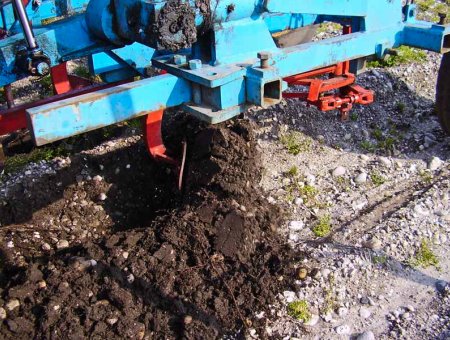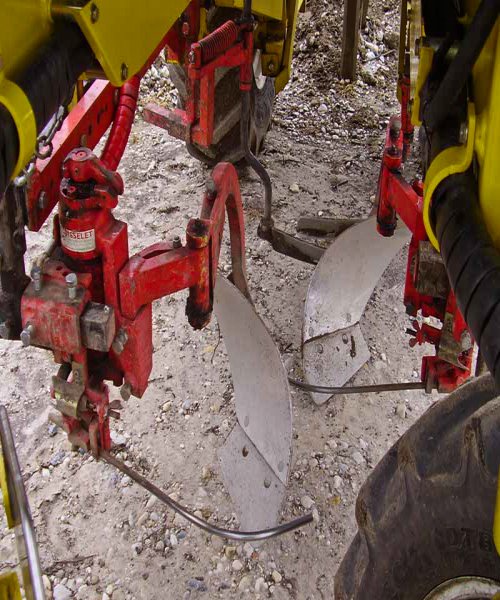Undervine plow
The decavaillonneuse plough is an agricultural tool designed to remove soil from under vine rows, available in mechanical or hydraulic versions. It consists mainly of a plough body, often fitted with a hydraulic device to facilitate clearance around the vines. The plough mouldboards vary in size, shape and slope according to soil type, planting width and vine shape.
Precise adjustment of the plough and feeler is crucial to avoid damaging the vines and optimise the tool's efficiency.
Precise adjustment of the plough and feeler is crucial to avoid damaging the vines and optimise the tool's efficiency.

Work objective
The undervine plow is a ploughing tool which, by design, removes the soil thrown under the row in the autumn. It can be mechanical or hydraulically assisted. Its use is sometimes essential when there is a lot of plant cover under the row.Component parts of the undervine plow
The plow body
The decavaillonneuse consists of a plow body with specially shaped shares and mouldboards adapted to the work to be carried out.This plow body is positioned on a device that allows it to retract as the vines pass.
On the earliest plows, the device for releasing the plow body was a deformable parallelogram, operated by the feeler which acted as a lever. Nowadays, hydraulic devices have become the norm.
The hydraulic cylinder
The hydraulic cylinder is the most widely used solution for removing the dethatching element. The cylinder, controlled by a distributor operated by a feeler, deforms the parallelogram and retracts the plow body. The distributor can be controlled mechanically or electro-hydraulically. Mechanical control requires slightly more effort to trigger, but is more progressive. The hydraulic system can be powered by the tractor's oil or by an independent control unit. At Egretier, the power unit is a closed-circuit unit with a low reservoir capacity (a characteristic linked to the closed circuit), but also the use of a special hydraulic fluid (LHM), so beware of errors.The hydraulic torque booster
The hydraulic torque amplifier, used by Boisselet, is a system that combines a rotary distributor coupled to a hydraulic motor in a single unit. Actuating the feeler causes a control shaft to rotate, which in turn causes an output shaft to rotate at the same angle. The role of this device is to multiply the torque between the two shafts. It is a compact, simple and robust device.Different types of mouldboard
The different choices available concern the size, shape and slope of the mouldboards.
Choosing
the size Determined
by 3 criteria: soil type, planting width and vine shape- .
- Impact of soil type
- The more clayey the soil, the higher the back of the mouldboard will be in relation to the ground.
- Impact of planting width
- In narrow vineyards (planting widths of 0.70 m to 1.40 m), shovelling is carried out with a single ridger body. As the planting width increases, so does the length of the mouldboard. The choice of mouldboard length for the decavaillonneuse, used as the sole means of removing soil, will also follow this rule.
- Impact of vine shape
- The higher the trunk of the vine, the more pronounced the upper curve of the mouldboard.

Undervine
plow
|-
|
The choice of shape
This is often determined by the length of the mouldboards. They are generally cylindrical or semi-helical in shape. The shorter the mouldboard, the more cylindrical its shape. The longer the mouldboard, the more helical the shape will be to accompany the soil.The choice of slope
This is essentially linked to the traction power: the greater the power, the greater the slope to enable the mouldboard to be cleared more easily. In the past, water bolts were used in clay-limestone soils to lubricate mouldboards on gentle slopes.Adjusting and using the mouldboard plow
Plow adjustment
The
first thing to do with inter-row tractors is to adjust the overall width of the tractor tyres. The tyres must fit into the furrows left by the previous "turns". The strip of soil that remains under the vines must not be crushed, as the plough shoes must be guided in the furrows.
The decavaillonneuse should be perfectly centred, and the stabilisers should have very little play.
Ploughshares should work horizontally and should not dig in or heel.
As a general rule, ploughshares should take up a strip of soil 20 to 30 centimetres wide, with the end of the mouldboard protruding a few centimetres (around 5 cm) below the axis of the row. This distance also depends on the shape of the ploughshares, in particular the aggressiveness of their tips, and the shape of the vines.
|The sensor should be very close to the ground to minimise the risk of ripping the vines, especially if the vines are twisted. Adjusting the sensor is important because it is the sensor that enables the tool to be triggered but also to return to work.
The distance between the sensor and the tip of the ploughshare determines the approach distance and the distance between the end of the sensor and the tip of the ploughshare determines the distance the plough returns to its working position. Setting the sensor directly affects the safety margin between the vine and the plough.
|The decavaillonneuse should be perfectly centred, and the stabilisers should have very little play.
Ploughshares should work horizontally and should not dig in or heel.
As a general rule, ploughshares should take up a strip of soil 20 to 30 centimetres wide, with the end of the mouldboard protruding a few centimetres (around 5 cm) below the axis of the row. This distance also depends on the shape of the ploughshares, in particular the aggressiveness of their tips, and the shape of the vines.
|The sensor should be very close to the ground to minimise the risk of ripping the vines, especially if the vines are twisted. Adjusting the sensor is important because it is the sensor that enables the tool to be triggered but also to return to work.
The distance between the sensor and the tip of the ploughshare determines the approach distance and the distance between the end of the sensor and the tip of the ploughshare determines the distance the plough returns to its working position. Setting the sensor directly affects the safety margin between the vine and the plough.

Inter-vine
sensors
Where to position your undervine plow?
Inter-row tractors
Generally speaking, dethatching ploughs are positioned on either side of a frame mounted on the tractor's 3-point system. However, decavaillonneuses can also be mounted at the rear of the vineyard plough frame. This arrangement is most common in vineyards with wide planting widths. For wide vines, there are also side-mounted units, mounted between the front and rear wheels of the tractor. This arrangement offers the advantage of good visibility of the work.Straddle tractors
For single rows, two ploughs are used, one behind the other, to work the space between the vines in the same row.Choice of share types
there are three main types of ploughshare- :
- Sharply rounded shares, which have to work with a parallelogram device and a sensor trigger.
- Skimmer shares, which allow parallelogram dethatching without a sensor. For safety reasons (protection of the stock), they are also mounted on de-tavellers with a sensor.
- Guard shares are used to maximise share detection when using parallelograms without a sensor.
Experiment
See the list of experimentsSee more 